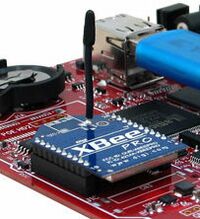XBee: Difference between revisions
No edit summary |
m (FTP links auto-updated (http://code.google.com/p/xbee-api/ → https://github.com/andrewrapp/xbee-api, http://code.google.com/p/xbee-api/ → https://github.com/andrewrapp/xbee-api)) |
||
| (5 intermediate revisions by 2 users not shown) | |||
| Line 10: | Line 10: | ||
|header2 = Documentation | |header2 = Documentation | ||
|data3 = [http://www.digi.com/pdf/ds_xbeemultipointmodules.pdf Datasheet] | |data3 = [http://www.digi.com/pdf/ds_xbeemultipointmodules.pdf Datasheet] | ||
|data4 = [ | |data4 = [https://www.digi.com/resources/documentation/digidocs/pdfs/90000982.pdf Product Manual] | ||
|data5 = [http://ftp1.digi.com/support/documentation/xbee_rpsma_mechanical_drawing.pdf Mechanical Drawing] | |data5 = [http://ftp1.digi.com/support/documentation/xbee_rpsma_mechanical_drawing.pdf Mechanical Drawing] | ||
|data6 = [http://www.digi.com/products/wireless-wired-embedded-solutions/zigbee-rf-modules/point-multipoint-rfmodules/xbee-series1-module.jsp Digi International] | |data6 = [http://www.digi.com/products/wireless-wired-embedded-solutions/zigbee-rf-modules/point-multipoint-rfmodules/xbee-series1-module.jsp Digi International] | ||
}} | }} | ||
= Overview = | = Overview = | ||
Many of our boards support the XBEE radios which can be used for long distance communication and mesh networking using the [ | Many of our boards support the XBEE radios which can be used for long distance communication and mesh networking using the [http://en.wikipedia.org/wiki/ZigBee ZigBee protocols]. | ||
= Getting Started = | = Getting Started = | ||
| Line 27: | Line 26: | ||
For programming with their series the Linux community has created libraries that make this very convenient. | For programming with their series the Linux community has created libraries that make this very convenient. | ||
* [ | * [https://code.google.com/archive/p/libxbee/ libxbee] is a C/C++ API for series 1, 2, and 5 XBEE modules in API mode. | ||
* [http://code.google.com/p/python-xbee/ python-xbee] is a python module for API and command mode | * [http://code.google.com/p/python-xbee/ python-xbee] is a python module for API and command mode | ||
* [ | * [https://github.com/andrewrapp/xbee-api xbee-api] is a java API for Series 1 and 2 in API mode. | ||
= Programming Example = | = Programming Example = | ||
This source example assumes the baud rate is already set up to 9600 and that you are using a series 1 XBEE module. Keep in mind that you can reprogram the baud rate that the XBEE module will use. First set up the UART before running your application: | This source example assumes the baud rate is already set up to 9600 and that you are using a series 1 XBEE module. Keep in mind that you can reprogram the baud rate that the XBEE module will use. First set up the UART before running your application: | ||
<source lang | <source lang=bash> | ||
eval $(xuartctl --server --port 3 --speed 9600 2>&1); ln -s $ttyname /dev/ttyxuart3 | eval $(xuartctl --server --port 3 --speed 9600 2>&1); ln -s $ttyname /dev/ttyxuart3 | ||
Latest revision as of 18:28, 3 February 2021
 | |
| Released Mar. 2010 | |
| Documentation | |
|---|---|
| Datasheet | |
| Product Manual | |
| Mechanical Drawing | |
| Digi International |
Overview
Many of our boards support the XBEE radios which can be used for long distance communication and mesh networking using the ZigBee protocols.
Getting Started
Digi offers the best introductions to these products:
XBee Learn More XBee 802.15.4 Digital Input/Output Line Passing
For programming with their series the Linux community has created libraries that make this very convenient.
- libxbee is a C/C++ API for series 1, 2, and 5 XBEE modules in API mode.
- python-xbee is a python module for API and command mode
- xbee-api is a java API for Series 1 and 2 in API mode.
Programming Example
This source example assumes the baud rate is already set up to 9600 and that you are using a series 1 XBEE module. Keep in mind that you can reprogram the baud rate that the XBEE module will use. First set up the UART before running your application:
eval $(xuartctl --server --port 3 --speed 9600 2>&1); ln -s $ttyname /dev/ttyxuart3
# Now that the xuart device is created you can start your application:
myapp &
This is an example application that will check for the "OK" return from +++. For real usage of the XBEE you will want to use one of the APIs listed above.
#include <sys/types.h>
#include <sys/stat.h>
#include <fcntl.h>
#include <termios.h>
#include <stdio.h>
#include <strings.h>
#define XBEEDEVICE "/dev/ttyxuart3"
int main(int argc, char **argv)
{
int fd, c, res;
struct termios oldtio, newtio;
char buf[255] = {0};
fd = open(XBEEDEVICE, O_RDWR | O_NOCTTY );
if(fd <0)
{
perror(XBEEDEVICE);
return -1;
}
tcgetattr(fd, &oldtio); /* save current port settings */
bzero(&newtio, sizeof(newtio));
newtio.c_cflag = CRTSCTS | CS8 | CLOCAL | CREAD;
newtio.c_iflag = IGNPAR;
newtio.c_oflag = 0;
/* set input mode (non-canonical, no echo,...) */
newtio.c_lflag = 0;
newtio.c_cc[VTIME] = 0; /* inter-character timer unused */
newtio.c_cc[VMIN] = 2; /* blocking read until 2 chars received */
tcflush(fd, TCIFLUSH);
tcsetattr(fd, TCSANOW, &newtio);
// Sending +++ within 1 second sets the XBee into command mode
write(fd, "+++", 3);
res = read(fd, buf, 255);
buf[res] = 0;
if(0 == strncmp(buf, "OK", 2))
{
printf("XBee Detected\n");
}
else
{
printf("Could not find XBee\n");
}
tcsetattr(fd, TCSANOW, &oldtio);
return 0;
}